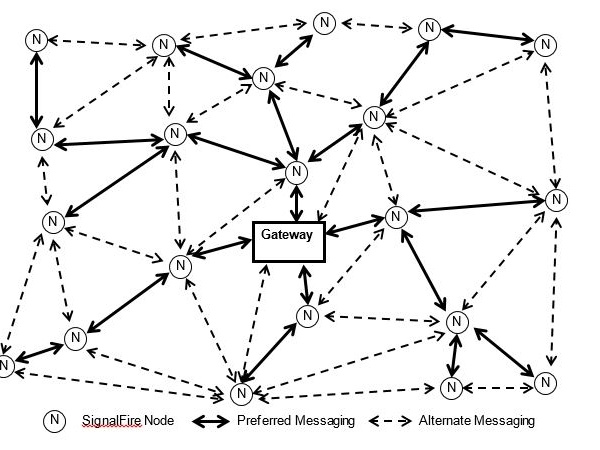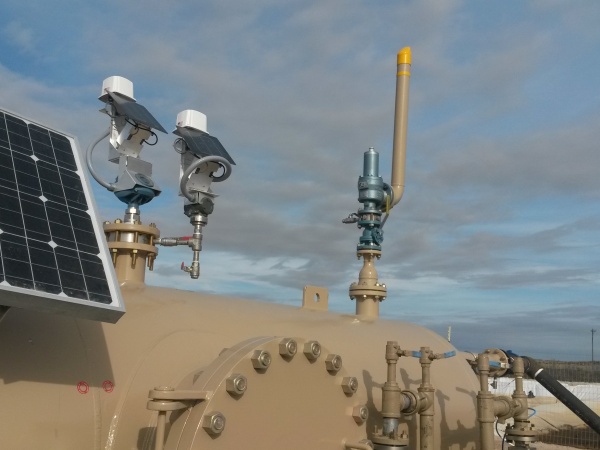Determining the Best Wireless Frequency for Your Remote Monitoring and Control System
Remote monitoring and control systems rely on radio communications to integrate their devices (sensors, nodes, Gateways) to a wireless network in the transmission of data. A large number of radio-based telemetry systems use communication networks based on a 2.4 GHz frequency band. For example, Zigbee, Wireless Hart, ISA 100 and other 802.15.4 systems operate in the 2.4 GHz wireless frequency spectrum.
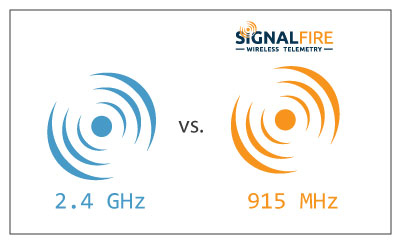
While ideal for short range building and plant environments, 2.4 GHz systems have limitations when performing in outdoor applications. A lower frequency is much better and a 915 MHz system provides a more reliable data transmission over longer ranges in more challenging environments.
The operating range or distance over which the wireless system must perform determines the best frequency band. When assessing the use of a 2.4 GHz or 915 MHz system, consider the following factors:
- Transmitter power
- Radio antenna design
- Interference
- Data rates
Transmitter Power/Antenna Design
In the US and Canada, 915 MHz systems can transmit powers up to 1 Watt and have antennas that can double that range (+6 dB). While 2.4 GHz systems can operate at the same power levels in the US and Canada, most do not exceed the global requirement of 0.1 Watts. Global restrictions on 2.4 GHz frequency further limit performance by measuring radiated power – no antenna gain is permitted for a full power (0.1 Watt) system in most countries.
With operating parameters being equal, a 915 MHz system offers about 2.6 times the range of a 2.4 GHz system. In most cases, the 915MHz supports longer range between nodes, beneficial for wireless sensor control networks that cover large geographic areas of hundreds of square miles.
Interference
Most wireless sensor control systems are subject to two types of interference that disrupt the communication signal: physical and electromagnetic.
Physical Interference
- Building Attenuation
- Either a 2.4 GHz or 915 MHz solution works efficiently in buildings. Figure 1 shows attenuation through the floors of a commercial building.
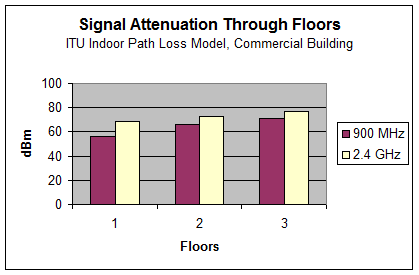
- Either a 2.4 GHz or 915 MHz solution works efficiently in buildings. Figure 1 shows attenuation through the floors of a commercial building.
- Vegetative Attenuation
- The impact of trees and other vegetation can significantly impact link quality. Evergreens are worse than deciduous trees. Wet foliage also degrades link quality even further. A 2.4 GHz system will experience significant foliage attenuation problems due to the moisture in vegetation as it operates close to the frequency that vibrates water molecules (like your microwave does).
- Figure 2 are the results of a wet foliage field test conducted with a SignalFire Remote Sensing System using both 909 MHz and 2.4 GHz frequency radio communications through 120 meters of wet foliage (170 meters total in a rainstorm) at 0oC with some ice formation. Both were tested using a transmission of 20 packets, 64 bytes per packet, 1 mW power. The 2.4GHz failed and, then, stopped operations during the test.
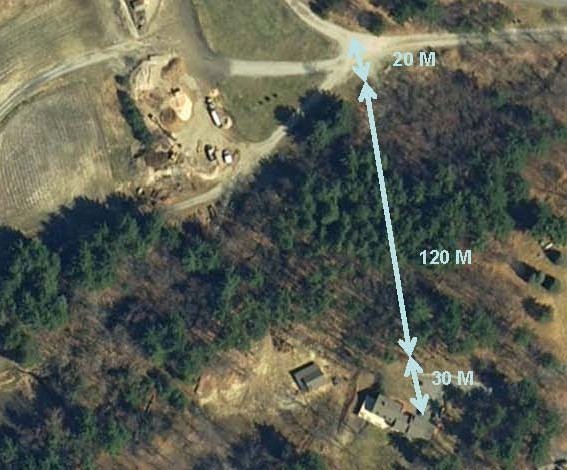
 Figure 2: Results of Wet Foliage Test conducted with SignalFire telemetry system operating on two different frequencies.
Figure 2: Results of Wet Foliage Test conducted with SignalFire telemetry system operating on two different frequencies.
- Rain Attenuation
- Rain attenuation is modest for both a 2.4 GHz and 915 MHz frequency. Fog and snow are slightly lower. Rain, however, will significantly exacerbate the foliage attenuation at 2.4 GHz due to the high absorption of the 2.4 GHz energy by water.
Electromagnetic Attenuation
Both frequencies use standard techniques to manage radio interference. Choice of methodology depends on system design.
- Zigbee, Wireless Hart, and ISA 100 at 2.4 GHz use Direct Sequence Spread Spectrum (DSSS) as a method of using multiple frequencies to avoid narrowband interference. This technique preserves high data rates until the interference band spreads to a point where data rates degrade quickly.
- While DSSS works at 915 MHz, SignalFire implements a Frequency Hopping Spread Spectrum (FHSS) that “hops” over narrowband interference. This technique assures communications, albeit at a lower data rate, where DSSS fails.
Data Rate
Data rate does significantly impact range. Most 2.4 GHz systems transmit at 200 – 500 Kbits/sec. A SignalFire Remote Sensing System operating at 915 MHz transmits at 10 Kbits/sec which is sufficient for telemetry applications but not for applications like live video feed. Doubling the data rate causes a 3 dB loss in link budget. When compared to a 200k bit/sec system, the SignalFire Telemetry System has an advantage of about 12 dB (6 dB= a doubling of range).
Conclusion
No one frequency provides the perfect solution in supporting the communications of a wireless telemetry or mesh network. While working well in building and plant environments at ranges measuring in tens of meters, a 2.4GHz frequency poses limitations in longer ranges and under certain outdoor conditions. A 915 MHz frequency offers a more reliable data transmission platform for outdoor applications where data must be reliably transmitted hundreds to thousands of meters under different weather conditions. The choice ultimately depends on the application, environment and how much data is transmitted.
Read about the Factors in Determining the True Range of a Wireless Sensor Control Systems
1 Comment
-
Thanks for the informative article – I was previously unaware of the relative impact of wet foliage on 900 MHz vs. 2.4 GHz.
Leave a reply
You must be logged in to post a comment.







